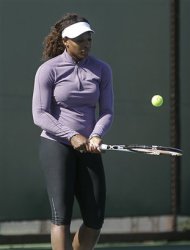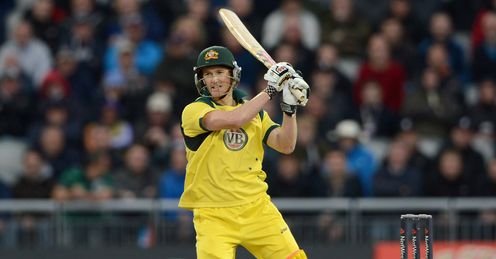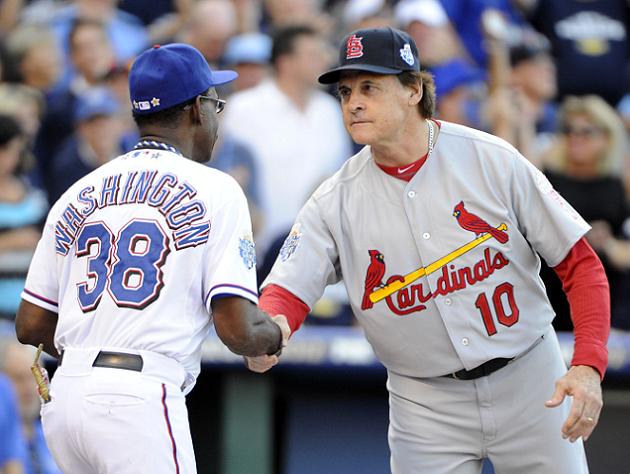STANFORD, Calif. (AP) -- Serena Williams has had little time to reflect on her first Grand Slam title in two years and even less time to sleep with a schedule she says is ''probably the most hectic it has been in my career.''
And it has only just begun.Three days removed from winning Wimbledon and less than three weeks away from returning to London to go for Olympic gold, a jet-lagged Williams was back on the court Tuesday - more than 5,000 miles and eight time zones away from the All England Club - in the serene setting at Stanford.
''I don't know really where I am right now,'' she joked.
The 14-time Grand Slam singles champion left London a day earlier, watched ''at least five movies'' on the flight - ''The Hunger Games'' was her favorite - because she couldn't sleep and only rested a few hours before she showed up on Court 10 wearing a pink, long-sleeved shirt and black capris in front of about a dozen spectators.
Leaving the London drizzle for the Stanford sunshine wasn't the only reason Williams returned.
The Bank of the West Classic, where the top-seeded Williams will defend her title beginning Wednesday against NCAA champion Nicole Gibbs of Stanford, holds special meaning for Williams. The tournament is where her comeback took shape last year when she beat Marion Bartoli in the finals for her first WTA title victory since returning from blood clots in her lugs and two foot operations that threatened her life and career.
''I really wanted to come here more than anything,'' Williams said. ''This is kind of where I felt like it began. Just getting on that plane and coming here to play is probably the best thing I could have done.''
What a way to gear up for the Games.
Not only did Williams win the singles title at Wimbledon, she also teamed with older sister Venus to capture the doubles crown. The ''super hectic schedule,'' as Williams refers to it, isn't slowing down either.
The two will be right back on grass at the All England Club when Olympic competition begins July 28.
Williams, now No. 4 in the world rankings, and Venus won gold in doubles in 2000 and 2008 and will go for a third again this year. Serena might also team with Andy Roddick or John Isner in mixed doubles. She has never medaled in singles.
A year ago at this time, even playing in the Olympics didn't seem possible.
Williams cut her feet on glass at a restaurant two weeks after her 2010 Wimbledon title, leading to a series of health problems for most of the next year, including being hospitalized for clots in her lungs. She also had a pocket of blood removed under the skin on her stomach.
Now she's back and better than ever.
''She's proven herself to be a great champion,'' Roddick said during a conference call Tuesday before a tournament in Atlanta. ''She's almost become a master of comebacks. I remember when, what, four or five years ago, she was below 100 in the world? People were wondering if that was it. She came back and dominated.''
Seemingly with ease, too.
What has propelled Williams more than anything is her serve. She broke her own Wimbledon record for aces in a match with 23 against Zheng Jie in the third round. Less than a week later, she eclipsed that mark with 24 against Victoria Azarenka in the semifinals and finished with 102 for the tournament.
Williams tossed a football around the Stanford courts Tuesday before practicing her serve - a motion her father, Richard, has said is similar to her racket swing. She used to toss the ball around as a kid, too.
Age hasn't slowed down Williams yet.
She is the first woman in her 30s to win Wimbledon since Martina Navratilova took home the title in 1990 at age 33. If she stays healthy, Williams has a chance to match Navratilova's total of 18 Grand Slam titles as well. Only Steffi Graf with 22 major championships has more.
''I've actually never felt this fit and this good in my entire life,'' Williams said. ''It's really, really, really weird but I've never felt this good.''
She could not have said that a year ago.
Williams walked onto the court at Stanford as the favorite then, but hardly the clear-cut choice she once was - especially entering the fall's U.S. Open, where she lost in the finals to Samantha Stosur. Now that punishing serve is back, and so are those hard-hitting strokes and fleet footwork that propelled Williams to the top of women's tennis.
Not to mention that aura of invincibility.
''I'm so in awe of her,'' said Gibbs, who was a ball girl for Williams for an exhibition in Cleveland when she was 12 years old. ''She's one of my idols growing up. I'm honored to play against her.''
Bartoli also is back in the field at Stanford as the No. 2 seed. Third-seeded Dominika Cibulkova and fourth-seeded Jelena Jankovic, both looking to shake off first-round losses at Wimbledon, figure to round out Williams' top competition.
In another example of how much has changed, Bartoli beat the former world No. 1 in straight sets in the fourth round at Wimbledon last year. Then Williams whipped the Frenchwoman in straight sets in the finals at Stanford.
And now?
''I'm glad I was able to play against her last year at Wimbledon because I think that was my best chance to ever beat her,'' Bartoli said. ''I predicted that last year here at Stanford. And I think my prediction was kind of right.''
---
AP Sports Writer Melissa Murphy in New York contributed to this story.




 (58) and Ravi Bopara (52 not out) sealed the win with a third-wicket stand of 92 which helped the hosts chase down a revised target of 138 with 11 balls to spare.
(58) and Ravi Bopara (52 not out) sealed the win with a third-wicket stand of 92 which helped the hosts chase down a revised target of 138 with 11 balls to spare.



